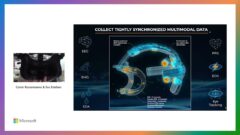UIST 2020 Visions Talks – Steve Hodges: Democratizing the Production of Interactive Hardware
UIST Visions Talks 2020 was chaired by Ken Perlin, New York University
THE IMPORTANCE OF INTERACTIVE HARDWARE
Whether it is intentional user interaction, continuous context or environmental sensing, or situated information display, we are dependent on interactive hardware to provide the vital connection between our ever-expanding networked computer systems and the real world. Indeed, as the “internet of things” computing paradigm becomes established, many predict a dramatic growth in the number and type of these interactive devices. A key factor in this growth is the ability of research communities like UIST to explore new device forms and functions, with the ultimate aim of unlocking new capabilities and experiences.
TWO PHASES OF HARDWARE DEVELOPMENT
The development of new interactive hardware can be split into two phases. Firstly, a period of ideation, prototyping and design iteration leads to new device concepts. Hardware researchers in the UIST community often excel at this! Many of us have even created systems and platforms to aid other researchers in their prototyping endeavors – reducing the time, money and/or level of expertise needed. Building prototypes has become democratized.
The second phase typically involves creating tens to thousands of copies of a prototype – either pre-production evaluation units or low-volume product. However, based on my own first-hand experience coupled with interviews with many others, this transition is often unexpectedly difficult. Certainly, the availability of cheap printed circuit board (PCB) manufacturing and assembly services can be enough. But as the complexity of a device moves beyond a single, routine PCB, and as the scale rises from tens to hundreds or thousands of units, the complexity and cost of reliable production can become overwhelming.
THE HIDDEN CHALLENGES OF SCALING HARDWARE
The underlying difficulty with transitioning from research prototyping to reliable production comes in the form of the non-recurring engineering (NRE) activities necessary after the prototyping phase. For example, extensive design verification and testing is needed to ensure that the performance shown by a prototype can be replicated consistently. Furthermore, each production unit must be tested to ensure it was assembled correctly, requiring a custom test jig and procedure to be developed – a process that can take longer than designing the product itself! And a final example: an early production unit must be tested for compliance with the regulations of the country/ies in which the devices will be deployed – often necessitating expensive design iteration.
Traditional solutions to the NRE activities listed above require costly expertise and equipment, meaning they are typically only cost-effective for mass production, i.e. in volumes of at least 10k units and often over 100k.
OVERCOMING THE TYRANNY OF MASS PRODUCTION
However, there is some good news. Just as our research community has developed a myriad of tools and techniques to reduce the cost and complexity of developing and deploying software, I believe new approaches can democratize hardware production, making it viable in much lower volumes.
Imagine “DevOps for hardware” – everything from circuit simulation tools that predict worst-case operating conditions and thereby simplify design verification, to re-usable hardware test jig designs that are readily ‘forked’ and adapted to suit a new device. Continuous integration and test-driven development could reduce or even eliminate regressions during the hardware design process, just as they do for software. Perhaps an augmented reality telepresence experience could allow device creators to ‘visit’ their chosen factory/ies more often, helping them understand the nuances of the production process and to pick up on and rectify potential issues. Domain-specific and AI powered tools could track the progress of a project, and automatically highlight the most relevant potential pitfalls.
DEMOCRATIZING HARDWARE: A CALL TO ACTION
I believe that with new tools and techniques such as those listed above, we can make low volume hardware device production viable. Furthermore, we can also support organic scaling, from tens of units through to hundreds and thousands. In this way, hardware innovations from the UIST community and beyond can have more impact. It will be easier for researchers to evaluate new ideas in the hardware space. Start-ups will face less risk when commercializing new hardware concepts, giving them headroom for iteration in search of product-market fit. Small companies will be able to manage a portfolio of niche but viable hardware devices, addressing the minority needs of individuals and communities. And larger organizations will be better placed to evaluate inventive ideas.
Recorded at the ACM UIST 2020 conference (opens in new tab).
- Date:
- Haut-parleurs:
- Steve Hodges
- Affiliation:
- Microsoft Research, Cambridge, UK
-
-

Steve Hodges
Senior Principal Researcher
-
-
Regardez suivant
-
Galea: The Bridge Between Mixed Reality and Neurotechnology
Speakers:- Eva Esteban,
- Conor Russomanno

